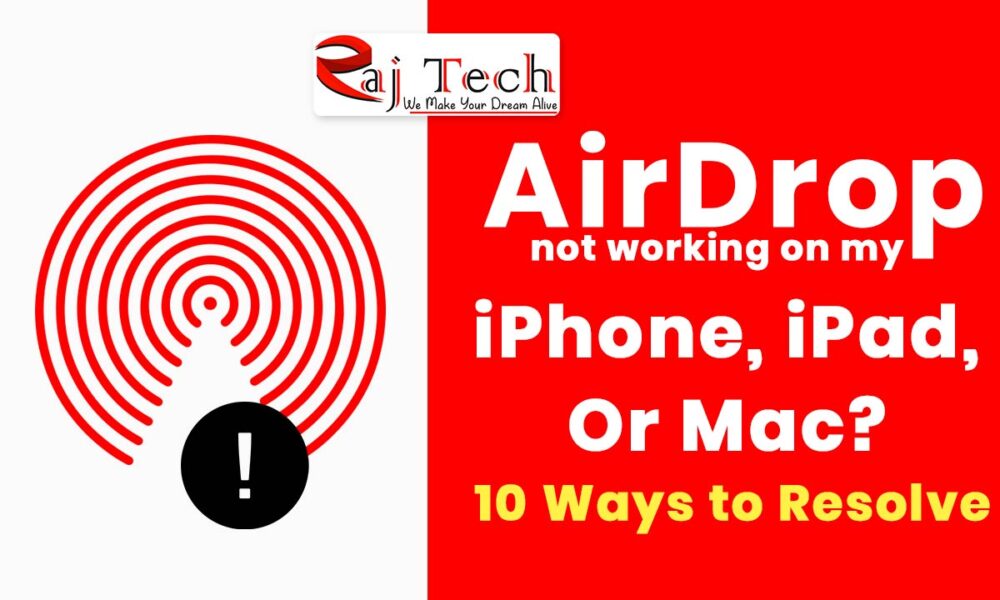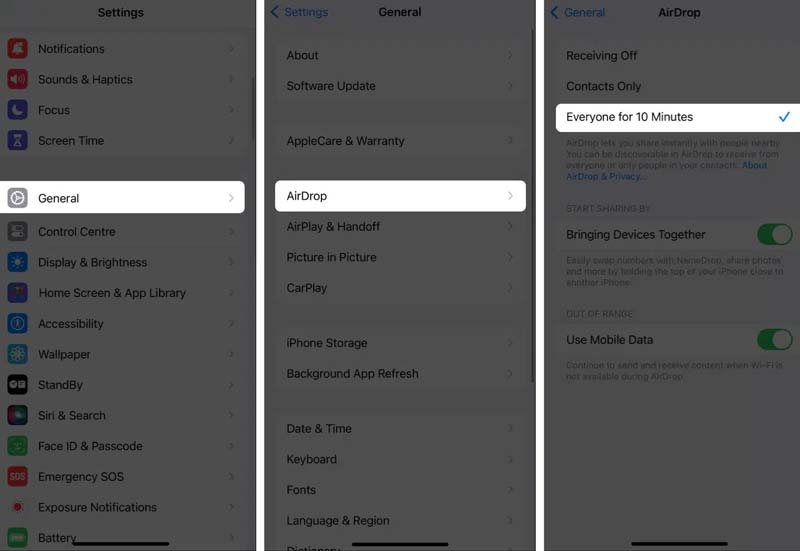AirDrop helps you to share files, contacts, photos, videos, and more with the original quality between Apple devices. But sometimes AirDrop not working on your Apple devices. Such as iPhone, iPad, or Mac are the Apple devices. Or maybe it can impact minor performance.
When it not working, sometimes it is due to wrong AirDrop settings or compatibility issues. Don’t worry in this article, Raj Chaubey covered all things. In the below paragraph, you will get an effective step solution that resolves your AirDrop issues on your Apple devices.
Contents
- Make sure your Apple Device is unlocked and turned ON
- Check the AirDrop settings
- Enable Bluetooth and Wi-Fi
- Turn OFF the Personal Hotspot
- Check and adjust your Mac’s Firewall
- Check the AirDrop Restrictions
- Restart your iPhone, iPad, or Mac device
- Turn OFF the VPN
- Bring both devices close together
- Reset your Network Settings
- Conclusion
1. Make sure your Apple Device is unlocked and turned ON
If you want your AirDrop to function properly then discoverability is more important. If your device is locked and dead then it may be not visible or unreachable in the list of search devices. As a result, the other person will not be able to send files or you will also be unable to receive any files.
So, if you are facing this type of issue in AirDrop transfer then make sure your Mac or iPhone is powered ON or unlocked, if not please do power ON or unlocked. If your device is ON or unlocked then ask the other person to make sure that the device is powered ON or unlocked, if not ask him to turn it on or unlock it.
2. Check the AirDrop settings for AirDrop not working
If your device is unlocked or powered ON, you still can not receive files from the other person. Then you should check your AirDrop settings. There are three ways to control the limit of visibility for AirDrop transfer to your iPhone or Mac device:
- Only Contacts: When you select this option, only saved contacts can view your device and send the files.
- Receiving OFF: This option makes your Mac or iPhone undiscoverable. That means, no one can view your device or send any files from the AirDrop.
- Everyone for only 10 minutes: A nearby person can view your device and share files.
You can understand, that each way affects your AirDrop transfer. So above you get the solutions, follow them, and resolve them.
On iPhone
- Open Setting then Go to General → Click AirDrop.
- Select ‘Everyone for 10 Minutes’ to receive files from nearby Apple devices or Only Saved Contacts.
- Here’s another way: Swipe down to open the Control Center, tap the network’s block in the top-left corner, press and hold the AirDrop button, and choose the option you need.
On Mac
- Open System Setting then Go to General → Click AirDrop & Handoff.
In the AirDrop option, select the option that you like.
- Alternatively, click the Control Center icon in the menu bar, select AirDrop, and turn it on. Then, choose a discoverability option that suits your preference.
3. Enable Bluetooth and Wi-Fi
AirDrop depends on Bluetooth and Wi-Fi networks to share files between two Apple devices. Now, Apple introduced the AirDrop transfer over cellular data with iOS 17. But that does not mean Wi-Fi is not needed. It needs to make any transfer. So, if AirDrop is not working, I suggest you do ON & OFF your Wi-Fi and Bluetooth settings.
On iPhone
- Open Settings then go to Wi-Fi and click OFF.
- Wait a couple of seconds then click ON to turn back ON Wi-Fi.
- Like the above Wi-Fi steps, go to Bluetooth and Click OFF.
- Wait a couple of seconds then Click ON to turn back ON Bluetooth.
On Mac
Open Settings then go to Wi-Fi and click OFF (If Wi-Fi is ON).
Wait a couple of seconds then click ON to again back ON Wi-Fi.
Exact as Wi-Fi, go to Bluetooth and Click OFF.
Wait a couple of seconds then Click ON to again back ON Bluetooth.
4. Turn OFF the Personal Hotspot
Whenever you enable your Personal Hotspot on your Apple iPhone then Wi-Fi automatically turn OFF. At this time, your AirDrop is unable to be used or may not work. So first, you want to turn OFF your iPhone Personal Hotspot then you should to again try sending or receiving AirDrop.
- Open Settings.
- Again open Personal Hotspot and Click OFF to Allow Others to Join.
- Alternatively, go to the network settings block in the Control Center and tap the Personal Hotspot button to turn it OFF.
5. Check and adjust your Mac’s Firewall
Basically on your Mac, the Firewall is designed to monitor with control all incoming and outgoing network traffic. In simple words, a Firewall prevents accepting incoming connections the unauthorized programs, applications, and services.
Nonetheless, too many restrictive Firewalls can disturb your setting of AirDrops and maybe prevent your transferring files. For example, a Firewall may change Bluetooth and Wi-Fi settings on your Mac could cause you to have trouble receiving AirDrop requests.
If you want to fix this issue on your Mac, then follow the below steps and adjust the Firewall settings.
- Open Settings → then select Networks → and click Firewall.
- Press the Options button.
- Now, check that ‘Block All Incoming Connections’ is turned OFF.
- Next, if it is not already ON then enable “Automatically allow built-in software to receive incoming connections”.
6. Check the AirDrop Restrictions
While it’s unlikely, you may have disabled AirDrop using Screen Time restrictions on your iPhone for some reason. If this is the case, the AirDrop icon might appear greyed out. To fix this, you’ll need to use Screen Time on your Mac or iPhone to remove the content and privacy restrictions you previously set.
On iPhone
- Open Settings → Click Screen Time → Select Content & Privacy Restrictions.
- Click Allowed Apps then click again on AirDrop.
On Mac
- Click Settings, select Screen Time → click Content & Privacy.
- Select App Restrictions, then click on AirDrop under the Allowed in iOS section.
7. Restart your iPhone, iPad, or Mac device
Sometimes restarting your iPad, Mac, or iPhone can fix minor software bugs or glitches. But sometimes, it does not work. So, you have to must do hard reset your device.
Follow these steps:
- Press & release the Volume Up button on your device.
- Press & release the Volume Down button on your device.
- Press & hold the Side button until the Apple Logo is visible.
- By clicking the Apple Menu > Restart, you can restart your Mac device.
8. Turn OFF the VPN
As mentioned, AirDrop uses the local network to transfer files between Apple devices. If you have an active VPN, it assigns a different IP address to your iPhone and changes the network configuration, which can make it hard for AirDrop to connect to other devices on the local network.
So, if AirDrop does not work on your iPad or iPhone device then disconnect the VPN and try again.
- Click Settings.
- Open to VPN and Device Management.
- Click OFF the Status switch.
These are steps to disable your VPN on a Mac device.
9. Bring both devices close together
Although AirDrop transfers over cellular data are now possible, the process still uses Bluetooth to initiate. If the two devices aren’t within Bluetooth range (about 10 meters), the other person’s iPhone won’t be visible on yours.
To fix this, bring the two devices closer together and try again.
Note: When bringing the two devices closer, ensure they don’t touch each other, as this can trigger the NameDrop feature.
10. Reset your Network Settings
Tried everything and still nothing works Or did AirDrop start working, but transfers are slower than usual? In that case, you can reset your Network Settings to fix any glitches or bugs affecting AirDrop performance.
Conclusion for AirDrop not working
That’s it! These are all the solutions that are tried and tested. That can help when AirDrop does not work on your iPhone, iPad, or Mac. However, if the issue persists, the Wi-Fi or Bluetooth hardware might be the problem, and seeking professional assistance is recommended.
If you have another solution that should be on this list, please share it with us in the comments.





 In the AirDrop option, select the option that you like.
In the AirDrop option, select the option that you like.












